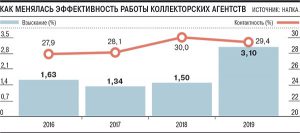January 29, 2020 – M.B.A. Finance took part in the publication of the newspaper “Kommersant”
But banks demand better results
Last year, debt collectors managed to increase the efficiency of recovery both purchased and agency-based services debts. This was facilitated by the rejuvenation of the portfolio and the growth of debt repayment through the court. However,
banks consider the efficiency growth to be technical and point to more effective work of internal debt collection services. It is possible that the results of the current year will satisfy creditors more, since debt collectors plan to boost the volume of returned debts.
According to a study by the SRO “National Association of Professional Collection Agencies”, by the end of 2019, debt collectors have increased the effectiveness of recovery both for cession and agency portfolios dramatically.
 So, last year, the average monthly share of recoveries increased more than twice (to 3.1%) in cession and 1.7 times (to 4.37%) in agency-based services. At the same time, debt collectors didn’t notice changes in the behavior of debtors in cession recovery. In particular, their level of contact, when the specified phone number is valid and the debtor is responsible for it, was 29.4% (30% in 2018), and the share of kept promises on payment was 51.1% (51.2% in 2018). In contrast, the level of contact in agency portfolios increased by 8.3 percentage points (pp) to 27.6%, while the level of kept promises added 19 pp to 45.5%.
So, last year, the average monthly share of recoveries increased more than twice (to 3.1%) in cession and 1.7 times (to 4.37%) in agency-based services. At the same time, debt collectors didn’t notice changes in the behavior of debtors in cession recovery. In particular, their level of contact, when the specified phone number is valid and the debtor is responsible for it, was 29.4% (30% in 2018), and the share of kept promises on payment was 51.1% (51.2% in 2018). In contrast, the level of contact in agency portfolios increased by 8.3 percentage points (pp) to 27.6%, while the level of kept promises added 19 pp to 45.5%.
According to the market participants, the increase in recovery efficiency was determined by several factors. According to Anton Dmitrakov, General Director of the collection agency EOS, this was achieved “due to the growth of debt collection in the framework of enforcement proceedings”. According to Pavel Mikhmel, General Director of FCB, in addition to this, individual work with clients also influences the growth of efficiency. “If we sign a debt repayment agreement with a client and receive an activation payment, we do not take the case to court. If the client stops paying and violates the terms of the agreement, we will activate a judicial penalty, ” he explains.
The growth of all indicators under the agency scheme was primarily facilitated by the “rejuvenation” of the portfolios transferred to work. In 2019, according to the Roman Volosnikov, General Director of NSR, “There is a tendency to increase the share of loans transferred for debt collection with a delay period of 180 to 360 days, while there is a steady decline in the share of loans with a delay period of more than 720 days.”
According to Elman Mekhtiev, the President of SRO NAPCA, the current indicators are quite high for the market. “In 2017, when the law on debt collecting of individuals came into a force, the effectiveness of debt collection was within 1.5%,” he recalls. – At the same time, debt collectors often work with the most difficult delay, where actions to recover by a lender for several months were unsuccessful. “However, despite the increase in the efficiency of debt collection, bankers are not very happy with the achieved indicators. “The increase in the efficiency of debt collection agencies associated with the transferred of debts on earlier dates or a change in a portfolio structure can be considered purely technical,” says Yevgeny Senkovsky, Deputy Director of the Department for dealing with overdue debts at ROSBANK.— In General, in our practice, debt collection agencies always lose out to the bank’s internal service in efficiency.” According to Maxim Bykov, Director of the Department for dealing with overdue debts of OTP-Bank, such increase in operational indicators on the side of agencies over the past year raises questions, since it did not have the same significant impact on the volume of returned debts.
However, it is possible that at the end of this year, the market participants will be more satisfied with each other, as debt collectors predict further growth in the efficiency of their work. “Since last year, there has been a decrease in the issuance of bank loans, this is due to the introduction of the debt load indicator,” says Fedor Vahata, General Director of “M.B.A. Finance”. – Debt collectors are very dependent on the strategy that is carried out by creditors. So, in the conditions of a careful approach to the selection of a client and the revision of the dates of the transferred debts to debt collection in the direction of reduction, efficiency will show growth.” According to Mr. Mekhtiev, this year the trend will continue, and the increase in efficiency may be about 15-20% for cession and 5% for agency-based debt collection.